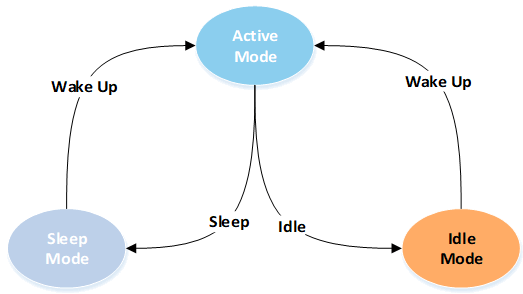Operating Modes
GR551x SoCs operate in three modes: Active, Idle, and Sleep.
- Active Mode
In this mode, the CPU of GR551x SoCs runs at full speed; users can configure and use peripherals on demand. Typical scenarios in this mode are described below:
- The MCU Subsystem (including ARM processors, SRAM, and peripherals) remains in standby or active state.
- The Bluetooth Subsystem (including RF Transceiver and Communication Core) remains in standby or active state.
- The PMU Subsystem (including DC/DC, LDO, and RTC) remains in active state.
- Idle Mode
The Idle Mode is configured by Wait For Interrupt/Wait For Event (WFI/WFE) command built in ARM processors. When this command is called, the PC pointer stops at the address of the WFI/WFE command; when an IRQ or event occurs in the system and CPU wakes up, the PC pointer points to the next command and continues implementing commands. Bluetooth tasks of GR551x SoCs are implemented based on interrupts. When the GR551x SoC is implementing Bluetooth tasks, users can configure the system to Idle Mode to reduce the power consumption; in the case of no Bluetooth tasks to be implemented, switch the Bluetooth Subsystem to POWER OFF Mode to further reduce power consumption.
- Sleep Mode
When there are no tasks to be processed on GR551x SoCs, users can configure the system to WFI/WFE state; to further reduce the power consumption, you can configure it to Sleep Mode. In this mode, the XTAL32M clock stops running, and the following modules are powered off:
- The MCU Subsystem (except for Retention SRAM)
- The Bluetooth Subsystem
In Sleep Mode, only Always-on (AON) Domain in the system is powered on, to prevent data stored in Retention SRAM from getting lost, and the modules with wakeup function are also powered on, including Bluetooth Low Energy (Bluetooth LE) Timer, Sleep Timer, Real Time Calendar, and AON GPIO.

The figure below shows the switching of system modes, which is completed automatically according to the current state.

For detailed description and configuration of the system mode, refer to "Mode Configuration".

